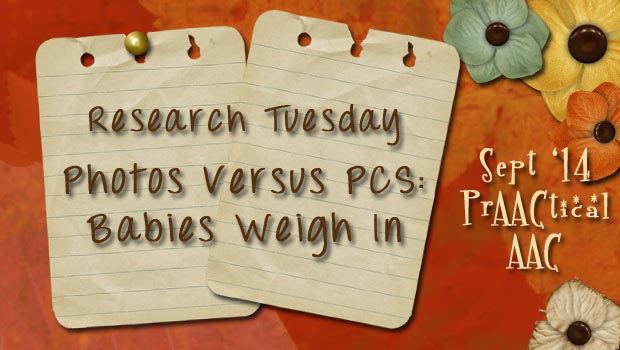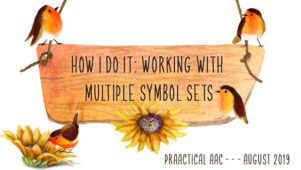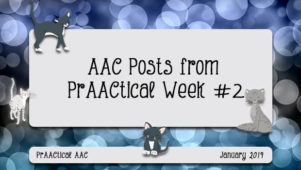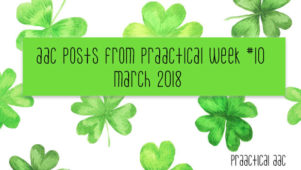Research Tuesday: Photos Versus PCS – Babies Weigh In

We’re back again with another Research Tuesday post, a series organized by Rachel Wynn of Gray Matter Therapy, in which bloggers are encouraged to write about a research article that they’ve read recently. (You may also know Rachel from her amazing work in advocating for ethical services in skilled nursing facilities.) For our September post, we look at a study done with babies to see how they like different AAC symbols.
SLPs frequently assume that children with AAC needs better understand and prefer photos to other forms of picture symbols used in AAC. In this article, we look at the work of special educator Alexandra DaFonte whose work gives us some insight into this issue.
In this study, she sought to determine if typically developing infants at 6, 9, and 12 months of age responded to two types of graphic symbols used in AAC: actual photographs and Picture Communication Symbols (PCS). An alternating treatment design with counterbalancing was used to see if the infants demonstrated a preference for one type of graphic symbol over another.
Photographs and PCS represented three categories of referents: food, toys, and “other items.” Using a survey, parents identified 12 preferred and 12 non-preferred objects. The researcher used generic items and not things specific to each infant’s personal life experience. Eight foods and eight toys were selected as referents for each infant. Half were preferred and half were non-preferred. Each referent was depicted with both photos and PCS.
The dependent variables measured in this study were the infant’s communicative behaviors, specifically vocalizations, eye gaze, and physical contact (e.g., reaching, grabbing). The active independent variables were the two types of graphic symbols mentioned earlier.
After a warm-up period, the infant was shown a board with a field of four symbols and asked “Where is the ___?” Responses were coded as correct if the baby demonstrated interest in the appropriate symbol by looking at it for at least 3 seconds, making physical contact with it, and/or smiling or vocalizing while looking at it. If the infants did these things for symbols that represented anything else, it was scored as incorrect.
In the intervention condition, three babies received 30 sessions of graphic symbol instruction over two weeks. Graphic symbols for four food items were used in each session. The researcher showed the infant one symbol at a time, labelling it twice. The symbols were put onto a communication board and labelled again (e.g.,”squash, prunes, pear, yogurt”). The researcher then asked which one the baby wanted. The infant was given a spoonful of whichever one was chosen. The three infants who served as controls were exposed to graphic symbols over the same amount of time, but no specific instruction was provided.Both procedural integrity and reliability of data were high (94-97%).
The results demonstrated that infants in any of the age groups did not have a statistically significant preference for one type of symbol over another.
- 6 months: photographs (mean = 58% ) and PCS (mean = 66%)
- 9 months: photographs (mean = 67%) and PCS (mean = 78%)
- 12 months: photographs (mean = 89%) and PCS (mean = 79%)
In terms of communicative modality, only babies in the oldest cohort used vocalizations for communication, which is consistent with existing developmental literature.
It’s still not known the extent to which this applies to older kids or those with developmental disabilities. It reminds us, though, to question our assumptions.
:::::::::::::::::::::::::::::::::::::::::::::::::::::::::::::::::::
Da Fonte, M. A., & Taber-Doughty, T. (2010). The use of graphic symbols in infancy: How early can we start? Early Child Development and Care, 180 (4), 417-439.
Filed under: PrAACtical Thinking
Tagged With: Alexandra da Fonte, babies, PCS, photos, Research Tuesday, symbols
This post was written by Carole Zangari





6 Comments
This article bears no brilliance to me since I work with a population of students who fall within the severe and profound range of functioning. The study’s comparison between photos and picture symbols involves typical developing children and not other impaired or non typically developing children so I see no relevance. I prefer to use symbols which foster a response or meaning to a child. It would have been more helpful if the study involved different groups of identified children such as ASD or Other category of impairments.
Bonnita, researchers are often reminded that the time and energy of people who use AAC is both limited and precious. They are encouraged to begin their lines of research, when appropriate, with typically developing individuals to get the basics of the project sorted out. Once that is done and they have some good ideas of how to proceed, they generally move on to working with people who have AAC needs. This is done with the best interests of people who use AAC in mind, particularly to avoid over-burdening them and their families at the early stages of research inquiry. I’m sorry that you found this less than helpful. Hopefully, one of the 1,022 other posts will better meet your needs. In any event, thanks for stopping by and taking the time to share your view.
Studying AAC questions in typically developing children has a lot of relevance to treating children with disabilities. From a practical standpoint, if possible it’s a good idea to try to mimic normal development – hence the importance of modeling – and this also demonstrates that an individual with a mental age of six to nine months might be successful with a graphical symbol system. Individuals with a cognitive disability often mostly follow the same trajectory as typical children, but at a slower pace.
From a theoretical standpoint, meanwhile, this is extremely important. It indicates that whatever cognitive prerequisites are required for graphic symbol use are already present in a typical 6-9 month old. And if an older disabled individual in that mental age range is not able to use graphic symbols, this is not merely due to their general cognitive delays, but rather a specific weakness. Just like how typical children master requesting and commenting at the same rate, while children and adults on the autism spectrum are often better at requesting than commenting. The fact that the requesting>commenting pattern is not shared by typical children suggests that it’s linked to a core feature in autism – reduced sociability.
You’ve made some good points, Ettina. There is still so much we don’t understand very well, and because research sometimes lags behind clinical practice, it can be hard to sort out what applies and what does not. Tracing a learning problem back to its roots can help us come up with working hypotheses that we can test out to see how that impacts our learners’ progress. Thanks for taking the time to share your thoughts on this.
It’s interesting that they chose to use symbols to match physical items. Do you know if there has been any similar research with icons/photographs that represent verbs, states of being, prepositions?
I don’t know of any Melissa, but they may have done additional studies since this was first published.